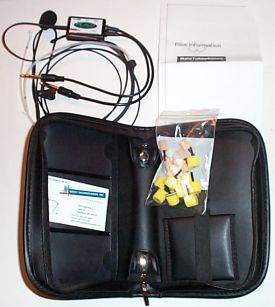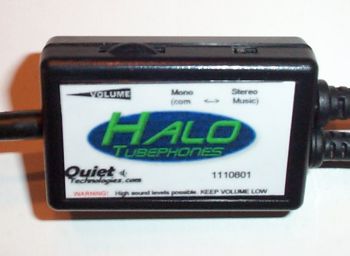new and used avionics
 Sell Your Avionics Here
Sell Your Avionics Here
|
Avionics List
new and used avionics |
 Sell Your Avionics Here
Sell Your Avionics Here
|
Buying Safety Tips |
Avionics Articles and Reviews
|
The Halo headset from Quiet Technologies, Inc is an in-ear featherweight headset that offers a lot of value for the price. Quiet Technologies claims the Halo is capable of delivering noise reduction comparable to or better than ANR headsets. While we lacked the audio test equipment to verify that claim, our real world tests showed the Halo to be a viable alternative to traditional headsets and a good choice for crew members and passengers on long cross-country flights.

From the standard aviation headphone and microphone plugs, leads run to a small control box with a mono/stereo switch and a single wheel for volume level. From the control box, a cord continues to miniature hearing aid speakers embedded in the headband. Flexible acoustic tubes are used to deliver sound from the speakers to the replaceable ear plugs. Quiet Technologies claims the tubes are longer lasting than wires used by competitors in their featherweight in-ear headsets. Compatible ear plugs are fitted with a small diameter hard plastic tube that delivers sound from the acoustic tubes through the center of the ear plugs to the ear canal.

The Halo headband can worn over or behind the head. The headband can be shaped with careful bending and is extendable on the side opposite of the microphone. Wearing a baseball cap is easy when the headband is used behind the head. After trying various ways of wearing the Halo, our testers largely preferred wearing the Halo behind the head with each side of the headband resting on an ear. Using glasses or sunglasses with the Halo is a piece of cake since there is virtually no interference with the Halo headband. Traditional headsets will press glasses temples into the side of the wearer's head. Glasses also reduce the noise attenuation capability of traditional earmuff headsets by creating a gap where the glasses pass underneath the ear seals.
Our first flight with the Halo was in a noisy single engine Cessna with a continental O-470 up front. Having used traditional headsets (David Clarks) for 19 years, it felt like something was missing and it was, mostly the weight, clamping force and sweaty ears. The sound quality was very good and radio communications with ground control were a snap. During the run-up it seemed like we were getting more noise than with the old David Clarks. On the takeoff roll the noise was obviously higher then we were used to with our old headsets. It was necessary to turn up the radio volume to understand instructions from the tower. Once we had reached our cruising altitude and reduced power the noise level was reduced but still much higher then what we were expecting. After landing we called Quiet Technologies support and explained the problem we were having with the unexpected noise level. Support correctly diagnosed the situation, we were not inserting the ear tips correctly.
Many of us of have been using foam ear plugs for years, so it's easy to assume we know how use them effectively. It turns out this is not the case and most people do not insert the ear plugs far enough into their ear canals. To realize the passive attenuation capabilities of the Halo headset it is crucial to get a good fit from the ear inserts. Without a tight, deep fit, noise will leak in, negating the attenuation potential of the Halo. With ear plugs there are two types of insertion, shallow and deep. Shallow insertion is how most people use ear plugs. Shallow insertion provides only a fraction of the potential noise attenuation of a deeply inserted ear plug. With deep insertion, the plug is tightly rolled and allowed to expand inside the ear canal. For foam type plugs, hold the plug in-place until it fully expands and a good seal is achieved. The Halo comes with two types of inserts a cylindrical foam type and a silicone flanged type. The silicone tips are not rolled, they are simply inserted. While easier to use, we found the silicone tips did not provide the same level of noise attenuation as the foam type inserts.

For traditional muff style headsets summertime means more sweating around the ears. With no ear cups that's not a problem with the Halo but we did have a small issue with the foam ear plugs in warmer temperatures. When temperatures are low, the foam plugs expand slowly after being rolled tightly. In warmer summertime temperatures the foam inserts expand faster making it important to inset them quickly and accurately. During our warm weather trials we've had to re-insert the foam plugs a few times after being too slow with our roll-insert technique.
Quiet Technologies has posted the following video on YouTube demonstrating proper insertion of foam ear tips.The second flight with the Halo was much better than the our first experience having mastered the art of proper ear plug insertion. Noise attenuation was outstanding and it was easy to understand how this featherweight headset does in fact have the potential to rival the noise reduction of traditional headsets. After a while it was easy to forget that we were wearing a headset at all.
During our real-world unscientific tests, we found the sound quality of the Halo to be excellent so long as the ear plugs are inserted correctly. While purely subjective, the quality of sound seemed to be on par and sometimes better than high-end traditional headsets. The microphone performed equally well with "loud and clears" from radio tests and a good side tone during radio transmissions.
During our evaluation of the Halo we contacted Quiet Technologies a number of times on their land line and also via email. The first time we called Quiet Technologies support we reached the owner Phil McCandless directly. The next time we called we reached voice mail but Phil returned our call within a few hours. We found email support to be good with replies returned in less than 12 hours. The quality of service offered was excellent and it was clear that Phil McCandless stands behind his product and wants customers to have the best experience possible with the Halo.
The unit is so light that it is easily dislodged when adjusting a hat or when leaning over to pickup something from the floor. The Halo comes with shirt clip which we found helpful as it can prevent an inadvertent tug on the cord from pulling the headband and inserts from your head. So traditional headsets win the inertia contest, but all of that mass can give you a headache as well.
This unit is very lightweight in part due to the lightweight cords. The small diameter cords are considerably smaller than those found on traditional style headsets. We are not sure how well the cords will hold up over time. A cramped cockpit is an unforgiving environment for loose cords and we would prefer the cords from the control unit to the headset be one size larger.
It only takes a few seconds to put on a traditional headset. The Halo takes a little more time. And if using the foam ear tips even more time to roll and insert the tips. The extra effort does not necessarily mean adding time to your trip. We learned to make use of the time when waiting for the engine oil to come up to temperature or getting ATIS to insert the ear tips.
Sometimes what goes into your ear comes out with a little extra - as in ear wax. If you use the ear plugs more than once, and we think most people will, they can become unsightly with wax build up. The foam tips are more difficult to keep clean as wax will work its way into the foam pores. Alcohol wipes do a fair job of removing ear wax from the plugs. Some users have reported success washing the ear tips with mild soap and water. If that's too much hassle then just replace the ear tips with a new set.
At the time of this writing, the Halo is priced at $359, a very competitive price for a featherweight insert type of headset. The Halo is available in two colors, black and cub yellow. Purchases can be made directly from Quiet Technologies, Inc. The Halo comes with a 30 day money back guarantee and a two year warranty for parts and labor.
For long trips the Halo has proved to be much more comfortable than traditional headsets. We used the Halo on days with over seven hours of IFR flying with ground temperatures exceeding 94 degrees. The advantage of the Halo becomes more noticeable with each passing hour. The overall experience is more relaxed and less fatiguing, allowing better concentration for all phases of flight, especially for instrument approaches at the end of a long trip. Pilots and passengers that don't mind inserting ear plugs will be rewarded by the Halo's light weight, good noise attenuation and excellent sound quality.